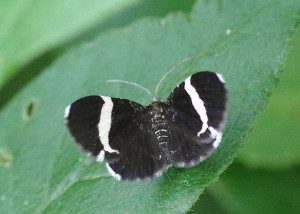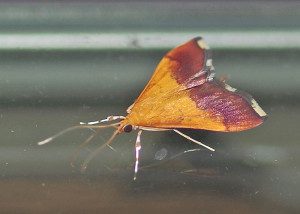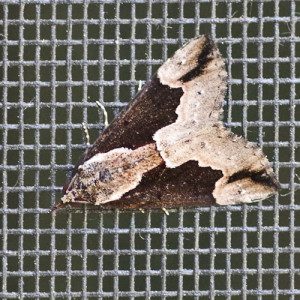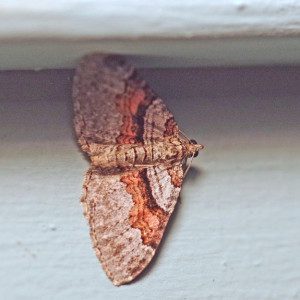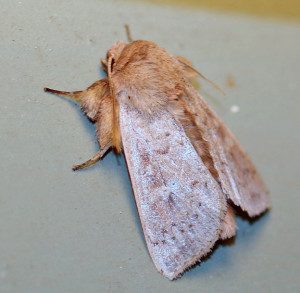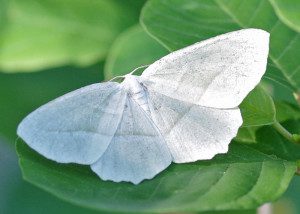Hey, BugFans,
It’s National Moth Week! Right now (July 23rd – 31st)!! Celebrating the 90% of the order Lepidoptera (“scaled wings”) that are not butterflies! Moths are diverse, successful, showy, drab, cryptic, abundant, huge (a few have wingspreads close to 12”), micro, tasty, toxic objects of our admiration, confusion, superstition and reverence. A Nature Center near you may be hosting moth-related activities; meanwhile, check out http://nationalmothweek.org/. And, as the folks at The Nature Conservancy say, “Don’t just sit there, do mothing!” (http://www.nature.org/
What else could you possibly name it but the WHITE-STRIPED BLACK MOTH (Trichodezia albovittata)? It’s in the moth family Geometridae, whose caterpillars are the “earth-measuring” inchworms, and it’s found over the northern two-thirds of North America. The BugLady usually sees this beauty around wetlands. Why? Because its caterpillars (http://bugguide.net/node/
Geometrids have paired “tympanal organs” (ears) at the base of the abdomen – most are nocturnal, and the ears let them hear communiques from other moths and the squeaks of bats. Though the day-flying White-striped black moth doesn’t encounter bats and it doesn’t produce sound, its vestigial ears allow it to hear ultrasound anyway. There are two generations per year.
The BugLady encountered the fingernail-sized BICOLORED PYRAUSTA (Pyrausta bicoloralis) (another well-named moth) in a wetland in mid-June in daylight, and more recently added it to her list of “porch light bugs.” It’s in the family Crambidae (Crambid snout moths), and it can be found in the eastern half of North America, and south into South America.
Bugguide.net notes that the life cycle of this widely-distributed species is “unknown,” including the caterpillar host plant(s) (which means – no caterpillar pictures) but mentions that the genus name Pyrausta comes from the Greek naturalist Pliny and means “a winged insect that was supposed to live in fire.” And – hmmmm – it seems like the moth on the BugLady’s not-very-clean window may be finding something to eat there.
The BALTIMORE SNOUT (Hypena baltimoralis), in the family Erebidae, has several aliases – it’s also called the Baltimore Hypena, and when it was in the genus Bomolocha, it was called the Baltimore Bomolocha. This common moth is found in damp woods and edges east of the Great Plains; there, its caterpillars feed on maples leaves, especially those of red and silver maple http://bugguide.net/
The Baltimore Snout is sexually dimorphic (not something the Supreme Court needs to rule on, that just means that there are differences between males and females – in this case, in coloration – the wings of females have a whitish sheen). There’s some variation in pattern and color http://mothphotographersgroup.
According to Wagner, in Owlet Caterpillars of the Northeast, “By day caterpillars rest on the undersides of leaves….. When disturbed, Hypena either launch themselves from their purchase or drop a belay line.”
The LABRADOR CARPET (Xanthorhoe labradorensis) is another Geometrid. Its range is listed as Alaska to Newfoundland, south as far as Louisiana and Mississippi, but with very few exceptions, the pictures submitted to bugguide.netcame from Canada and the northern tier of states. The caterpillars feed on a variety of different plants, both woody and herbaceous. There’s a single generation per year, and they probably overwinter as pupae.
There are a bunch of moths called carpets – not the notorious carpet moths, just carpets – Black-banded, Dark-marbled, Fragile white, Many-lined, Somber, Unadorned – it sounds like the namers of Carpets have as much fun as the namers of Underwings. Why “carpet?” One explanation comes from a book called Half Hours with Insects by A.S. Packard, published in Boston in 1881 (Google it – it’s lovely and you can read it on line). “Some geometrid moths are called carpet moths in England from the large number observed carpeting the lichen and moss-grown rocks of Scotland.”
The FALSE/HAIRY-LEGGED WAINSCOT (Leucania pseudargyria) is in the Owlet moth family Noctuidae (the BugLady thinks that this is the False Wainscot rather than the almost-as-fuzzy Ursula Wainscot). It lives from Manitoba to the Maritimes and south to the southern Appalachians; its habitat includes grasslands, wetlands, and woodlands, and its caterpillars munch on a variety of grasses, both wild and domestic. There’s a single generation per year; the wainscot overwinters as an almost-mature caterpillar and pupates in the spring.
The PALE BEAUTY MOTH (Campaea perlata) (“perlata” meaning “pearly” in Latin) is a Geometrid whose caterpillar (http://bugguide.net/node/
Males and females look alike, except that females are much larger (more sexual dimorphism), and the adults range in color from pearly white through pale yellow to light green (http://
Go outside. Turn on the porch light. Find some moths.
Kate Redmond, The BugLady
Bug of the Week archives:
http://www4.uwm.edu/

